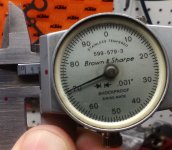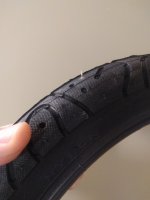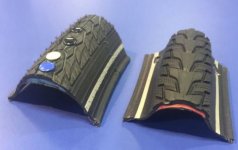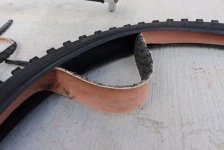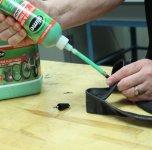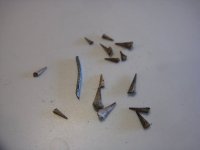Howdy folks.
I've been haunted by flat tires due to goatheads and have been doing very little riding due to it for the past 3 years.
Spent hundreds of dollars on "flat proof" bicycle oriented solutions over the years to no avail. That list includes the beloved marathon plus, slime, stans, tire liners, etc. Nothing lasts long on these roads. The only thing i have not tried is 'tire in a tire', suggested by amberwolf et al.
I decided that moto tires were the most ideal way out of this mess. I don't see motorcycle riders pulled over to change out a tire because of goatheads. Never changed a tire on a car because of a goathead. So my conclusion is: more rubber = more better.
Recently spent about $175 buying various motorcycle tires to see which one had the best rubber to weight ratio. These were cheap on a site called 'treatland'. A lot cheaper than puncture proof bicycle tires, actually!
I'm not covering knobby tires here - just street tires with nice efficient treads - because motorcycle tires already have punishingly bad tire friction on a bike!
Not included in this comparison is a Schwalbe 20" x ~2" tire, which had a 5mm of pin protrusion in the center of the tread, and a vee rubber 16 x 2.0" that had 5mm of protrusion and weighed ~2lbs. The general verdict is that if the tire is under 3lbs, it's garbage for this purpose. Might as well buy a BMX tire at that point.
On to the tests..
Here is the highly scientific device i used to measure the length of rubber on each tire :lol:
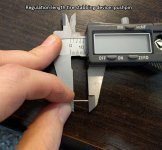
First up is a Hutchinson Spherus. I was very excited about this tire because it has a bicycle-like tread and won't stand out to the lawmen on my already goofy looking bike.

Sadly, this is basically a bicycle tire. It also looks more like a 2 inch wide tire.. it is very tall and rather narrow..
Next up is a Mitas MC2, which was recommended to me by treatland in an email to their sales team. I was told that this had low rolling resistance and that solar vehicle teams loved it.

This is actually a very impressive tire, and yes... it is hard, so perhaps the low rolling friction bit is the real deal?
Next up.. a Shinko 714 recommended by a member here.

I have to say i wasn't very impressed with the protrusion on the sidewall, considering the weight of the tire.
Next up is a tire that is popular on this forum, the Pirelli ML75.
View attachment 1
Super impressive stab test result! also the same weight as the Shinko! But a bit softer than the Shinko, and i imagine it will have a lot of tire friction as a result.
One interesting thing is that 'tire ply' basically means nothing. The ML75 is the thickest, but rated as 2 ply.
Here is a group shot of the tires to illustrate their differences.
So what's the winner? for me, the Mitas MC2 because of it's nice spherical shape ( seems ideal for hard cornering ), theoretically low rolling resistance, acceptible weight, and coming in at nearly half the price of the Pirelli. I believe that the harder compound will make the 0.5mm discrepancy between the Pirelli not matter, as the rubber will compress once you sit on the bike.
But the Pirelli is a fantastic if you need a 2.5" width or need the sticky rubber! if you're looking for the best rubber to weight ratio.. that's the one!
Two other tires that looked appealing but were not tested were..
Continental Contigo! - only 3lbs, so i expected to be disappointed.
Heidenau M4 - no weight listed, more of an "all season" type tire.. probably has bad rolling resistance, but looks like a quality tire.
Of course, what happens on the road and in the *cough* lab are going to be two different things. I only wanted to know how thick the tire is, not it's riding characteristics. But for me, there's no use in good riding characteristics if the damn thing pops every 5 miles. Hopefully this has been informative to y'all.
I've been haunted by flat tires due to goatheads and have been doing very little riding due to it for the past 3 years.
Spent hundreds of dollars on "flat proof" bicycle oriented solutions over the years to no avail. That list includes the beloved marathon plus, slime, stans, tire liners, etc. Nothing lasts long on these roads. The only thing i have not tried is 'tire in a tire', suggested by amberwolf et al.
I decided that moto tires were the most ideal way out of this mess. I don't see motorcycle riders pulled over to change out a tire because of goatheads. Never changed a tire on a car because of a goathead. So my conclusion is: more rubber = more better.
Recently spent about $175 buying various motorcycle tires to see which one had the best rubber to weight ratio. These were cheap on a site called 'treatland'. A lot cheaper than puncture proof bicycle tires, actually!
I'm not covering knobby tires here - just street tires with nice efficient treads - because motorcycle tires already have punishingly bad tire friction on a bike!
Not included in this comparison is a Schwalbe 20" x ~2" tire, which had a 5mm of pin protrusion in the center of the tread, and a vee rubber 16 x 2.0" that had 5mm of protrusion and weighed ~2lbs. The general verdict is that if the tire is under 3lbs, it's garbage for this purpose. Might as well buy a BMX tire at that point.
On to the tests..
Here is the highly scientific device i used to measure the length of rubber on each tire :lol:

First up is a Hutchinson Spherus. I was very excited about this tire because it has a bicycle-like tread and won't stand out to the lawmen on my already goofy looking bike.

Sadly, this is basically a bicycle tire. It also looks more like a 2 inch wide tire.. it is very tall and rather narrow..
Next up is a Mitas MC2, which was recommended to me by treatland in an email to their sales team. I was told that this had low rolling resistance and that solar vehicle teams loved it.

This is actually a very impressive tire, and yes... it is hard, so perhaps the low rolling friction bit is the real deal?
Next up.. a Shinko 714 recommended by a member here.

I have to say i wasn't very impressed with the protrusion on the sidewall, considering the weight of the tire.
Next up is a tire that is popular on this forum, the Pirelli ML75.
View attachment 1
Super impressive stab test result! also the same weight as the Shinko! But a bit softer than the Shinko, and i imagine it will have a lot of tire friction as a result.
One interesting thing is that 'tire ply' basically means nothing. The ML75 is the thickest, but rated as 2 ply.
Here is a group shot of the tires to illustrate their differences.
So what's the winner? for me, the Mitas MC2 because of it's nice spherical shape ( seems ideal for hard cornering ), theoretically low rolling resistance, acceptible weight, and coming in at nearly half the price of the Pirelli. I believe that the harder compound will make the 0.5mm discrepancy between the Pirelli not matter, as the rubber will compress once you sit on the bike.
But the Pirelli is a fantastic if you need a 2.5" width or need the sticky rubber! if you're looking for the best rubber to weight ratio.. that's the one!
Two other tires that looked appealing but were not tested were..
Continental Contigo! - only 3lbs, so i expected to be disappointed.
Heidenau M4 - no weight listed, more of an "all season" type tire.. probably has bad rolling resistance, but looks like a quality tire.
Of course, what happens on the road and in the *cough* lab are going to be two different things. I only wanted to know how thick the tire is, not it's riding characteristics. But for me, there's no use in good riding characteristics if the damn thing pops every 5 miles. Hopefully this has been informative to y'all.


